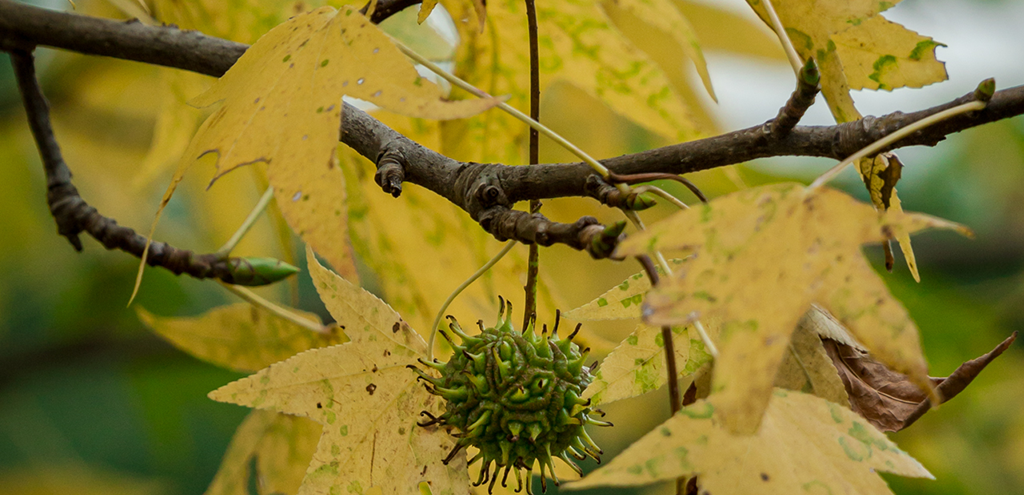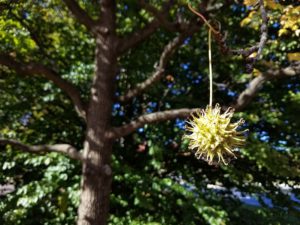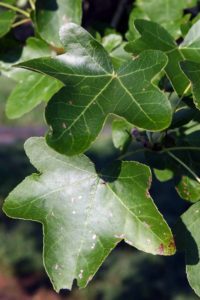THE LEAFLET

Which is Which: Sweetgum Edition
Tree identification is a journey. You start with recognizable, unusual, indisputable features like the leaves of the ginkgo or the exfoliating bark of a London planetree. But as you continue on your journey, it’s easy to spot swaths of species – that’s a magnolia, that looks like an oak, I bet that’s a maple – but it’s trickier to hone in on species level identification. Enter our newest series – Which is Which – designed to answer that very question!
Up next we’re looking at a stunning fall tree, the American sweetgum, Liquidambar styraciflua. Want to dive into more Tree ID? Check out our on-demand remote Your City, Your Trees classes! Want to find some sweetgum near you? Look around our Fall Colors Map for sweetgum. If you want to get down and dirty yourself, you can get up to $100 back for planting this tree yourself through our tree rebate program.
Known for its brilliant orange-red fall foliage, star-shaped leaves and distinct seed pods, sweetgums are durable urban shade trees with seeds that are valued by wildlife. Its common name, Sweetgum, refers to the aromatic gum that oozes from wounds to the tree.
 The best way to recognize the sweetgum is by its five-pointed, star-shaped leaves that bear a close similarity to some members of the Maple species. The leaves are alternate and serrated, with a long stem attaching it to the branch and tinted in a rich green color. In the fall the sweetgum really stands out as its leaves turn to a brilliant spectrum of red, yellow, orange, and purple colors.
The best way to recognize the sweetgum is by its five-pointed, star-shaped leaves that bear a close similarity to some members of the Maple species. The leaves are alternate and serrated, with a long stem attaching it to the branch and tinted in a rich green color. In the fall the sweetgum really stands out as its leaves turn to a brilliant spectrum of red, yellow, orange, and purple colors.
 The fruits of Liquidambar styraciflua are easily recognizable due to their round, hard and spiky shape. It is often the bane of some homeowner’s existence because of its troublesome fruit. In 2018 Green Cities Summit Keynote Speaker Michael Dirr’s entry for Sweetgum in his widely recognized Dirr’s Hardy Trees and Shrubs, it states “This lovely tree would be on every gardener’s wish list were it not for the woody, spiny, capsular, 1″ to 1 ½” diameter fruit, which abscise through fall and winter.”
The fruits of Liquidambar styraciflua are easily recognizable due to their round, hard and spiky shape. It is often the bane of some homeowner’s existence because of its troublesome fruit. In 2018 Green Cities Summit Keynote Speaker Michael Dirr’s entry for Sweetgum in his widely recognized Dirr’s Hardy Trees and Shrubs, it states “This lovely tree would be on every gardener’s wish list were it not for the woody, spiny, capsular, 1″ to 1 ½” diameter fruit, which abscise through fall and winter.”
 Well, well, well what do you – an important sweetgum cultivar is Liquidambar styraciflua ‘Rotundiloba’ also known as the fruitless sweetgum. Introduced in 1997, this tree doesn’t produce or rarely produces those spiny, messy fruits. It also grows slower and has a more open pyramidal shape. The important thing to note for tree ID? The leaves have the same 5 lobes, but the tips are rounded rather than pointed.
Well, well, well what do you – an important sweetgum cultivar is Liquidambar styraciflua ‘Rotundiloba’ also known as the fruitless sweetgum. Introduced in 1997, this tree doesn’t produce or rarely produces those spiny, messy fruits. It also grows slower and has a more open pyramidal shape. The important thing to note for tree ID? The leaves have the same 5 lobes, but the tips are rounded rather than pointed.
The sweetgum is one of the most common hardwoods in the eastern United States, found along most of the eastern United States: from Connecticut to southern Florida, and from the swells of the Atlantic all the way to Oklahoma. Another bonus? Liquidambar styraciflua is fairly adaptable to different conditions. It prefers moist, acidic or loamy soils and can tolerate poorly drained and salty soils as well.